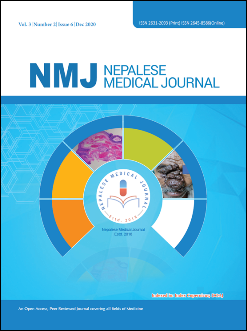Diet Pattern and Dyslipidemia Among Type II Diabetes Mellitus Patients Diagnosed More Tthan One Year Visiting Tribhuvan University Teaching Hospital
DOI:
https://doi.org/10.3126/nmj.v4i1.37495Keywords:
Dietary pattern; Dyslipidemia; HbA1; Type 2 diabetes mellitusAbstract
Introduction: Dyslipidemia is a risk factor for coronary artery disease, a leading cause of mortality in patients with type 2 diabetes mellitus. This study aims to study the dietary pattern and dyslipidemia of type 2 diabetes mellitus patients visiting Tribhuvan University Teaching Hospital.
Materials and Methods: Quantitative study was done to find out the dietary pattern and dyslipidemia of type 2 diabetes mellitus patients visiting Tribhuvan University Teaching Hospital. Patients with type 2 diabetes mellitus diagnosed for more than one year were included in the study.
Results: The percentage of dyslipidemia in type 2 diabetes mellitus was found to be 88.5%. Dyslipidemia was found to be significantly associated (p<0.05) with alcohol consumption, regular dietary management, sedentary behavior, waist-hip ratio, body mass index, glycated hemoglobin, and hypertension. Dyslipidemia was also found to be significantly associated (p<0.05) with the dietary habit (vegetarian and non-vegetarian), consumption of cereals and its product, consumption of fruits, consumption of fast foods and street foods, consumption of red meat, and consumption of oilseeds.
Conclusions: This study indicates the importance of dietary awareness and lifestyle modification for the management of dyslipidemia among type 2 diabetes mellitus.
Downloads
Downloads
Published
How to Cite
Issue
Section
License
Copyright (c) 2021 Aarem Karkee, Samiksha Niroula, Rama Subba

This work is licensed under a Creative Commons Attribution 4.0 International License.
This license enables reusers to distribute, remix, adapt, and build upon the material in any medium or format, so long as attribution is given to the creator. The license allows for commercial use.
Copyright on any article published by Nepalese Medical Journal is retained by the author(s).
Authors grant Nepalese Medical Journal a license to publish the article and identify itself as the original publisher.
Authors also grant any third party the right to use the article freely as long as its integrity is maintained and its original authors, citation details and publisher are identified.




